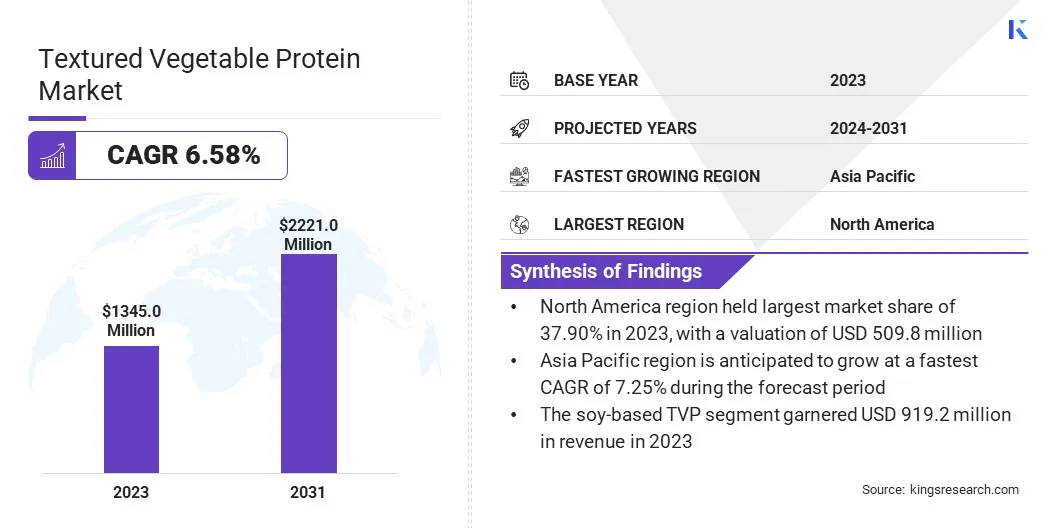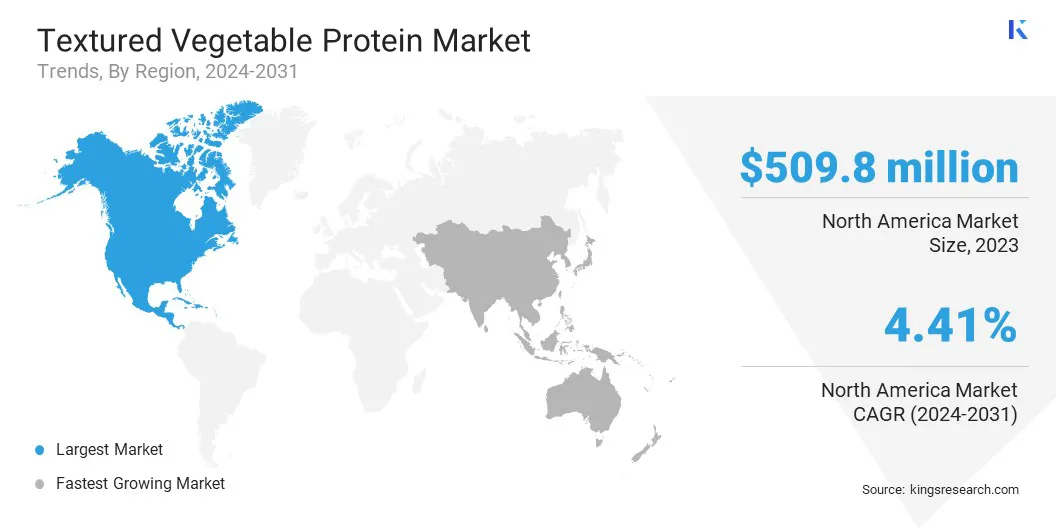Market Definition
The textured vegetable protein (TVP) market comprises soy-based, pea-based, wheat-based, and other plant-derived TVP products in forms such as chunks, flakes, granules, and slices. TVP is widely used in meat alternatives, snacks, convenience foods, bakery & confectionery, and animal feed for its high protein content and versatility.
Textured Vegetable Protein Market Overview
The global textured vegetable protein market size was valued at USD 1,345.0 million in 2023 and is projected to grow from USD 1,422.2 million in 2024 to USD 2,221.0 million by 2031, exhibiting a CAGR of 6.58% during the forecast period.
Market growth is primarily driven by the increasing demand for plant-based protein alternatives, rising health consciousness among consumers, and growing concerns about environmental sustainability
Major companies operating in the textured vegetable protein industry are Puris, BENEO, Foodchem International Corporation, Victoria Group, Crown Soya Protein Group Company, Shandong Yuxin Biotechnology Co., Ltd, A&B Ingredients, Inc, dsm-firmenich, MGP Ingredients, ADM, Roquette Frères, Axiom Foods, Inc., Kriti Nutrients, AGT Food and Ingredients Inc., Sun Nutrafoods, and others.
As consumer preferences shift toward healthier and more sustainable food options, manufacturers investing in innovation, transparency, and product differentiation will gain a competitive edge in the expanding market. Rising demand for high-quality, plant-based protein alternatives is fueled by health consciousness, ethical considerations, and sustainability initiatives.
- In February 2024, Roquette launched NUTRALYS T Pea 700FL and NUTRALYS T Pea 700M, strengthening its presence in the market. These innovations improve texture, protein content, and formulation versatility in plant-based meats, dairy alternatives, and nutritional products, reinforcing Roquette’s position in the plant-protein sector.

Key Highlights:
- The textured vegetable protein industry size was recorded at USD 1,345.0 million in 2023.
- The market is projected to grow at a CAGR of 6.58% from 2024 to 2031.
- North America held a share of 37.90% in 2023, valued at USD 509.8 million.
- The soy-based TVP segment garnered USD 919.2 million in revenue in 2023.
- The flakes/granules/slices segment is expected to reach USD 738.5 million by 2031.
- The meat alternatives segment is projected to generate a revenue of USD 1,046.0 million by 2031.
- Asia Pacific is anticipated to grow at a CAGR of 7.25% over the forecast period.
Market Driver
"Growing Demand for Plant-Based Protein Alternatives"
The growth of the textured vegetable protein market is driven by the rising demand for plant-based protein alternatives. Consumers are increasingly shifting away from animal-derived proteins due to health, environmental, and ethical concerns.
The increasing adoption of plant-based diets is fueled by growing awareness of their health benefits, such as lower risks of cardiovascular diseases and obesity. In response, foodservice providers, including major fast-food chains and restaurants, are expanding plant-based menu options to cater to growing demand.
- A report in the July 2024 Lancet Planetary Health indicates that a 30% reduction in red and processed meat consumption among American adults could prevent 382,400 cardiovascular disease cases over a decade, boosting demand for TVP-based products.
Market Challenge
"Texture and Taste Optimization"
The primary challenge hampering the expansion of the textured vegetable protein market is replicating the taste, texture, and mouthfeel of animal-based proteins. Consumers seek plant-based meat alternatives that closely mimic traditional meat, which remains a significant hurdle for TVP manufacturers.
Many TVP products struggle with achieving a juicy, fibrous, and realistic texture, limiting their mainstream appeal. Advancements in food technology, such as high-moisture extrusion and fermentation-based protein enhancement, are improving TVP's textural quality.
Collaborations between food scientists and plant-based product developers can foster innovations to bridge this sensory gap. Additionally, leveraging natural flavor enhancers and fat-mimicking ingredients can improve taste and consumer acceptance.
Market Trend
"Expansion of Clean-Label and Non-GMO TVP Products"
The key trend shaping the textured vegetable protein market is the growing preference for clean-label and non-GMO plant-based protein sources. Consumers are increasingly scrutinizing food labels, favoring products with minimal artificial additives, preservatives, and genetically modified ingredients.
This trend is particularly strong among health-conscious individuals and those adhering to organic and natural diets. In response, TVP manufacturers are reformulating their products with natural binding agents, plant-based flavorings, and organic protein sources to cater to this demand. As clean-label trends grow, manufacturers that align their offerings with these preferences are anticipated to gain competitive edge.
Textured Vegetable Protein Market Report Snapshot
|
Segmentation
|
Details
|
|
By Source
|
Soy-based TVP, Pea-based TVP, Wheat-based TVP, Others
|
|
By Form
|
Chunks, Flakes/Granules/Slices
|
|
By Application
|
Meat alternatives, Snacks & convenience foods, Bakery & confectionery, Animal feed
|
|
By Region
|
North America: U.S., Canada, Mexico
|
|
Europe: France, UK, Spain, Germany, Italy, Russia, Rest of Europe
|
|
Asia-Pacific: China, Japan, India, Australia, ASEAN, South Korea, Rest of Asia-Pacific
|
|
Middle East & Africa: Turkey, UAE, Saudi Arabia, South Africa, Rest of Middle East & Africa
|
|
South America: Brazil, Argentina, Rest of South America
|
Market Segmentation
- By Source (Soy-based TVP, Pea-based TVP, Wheat-based TVP, and Others): The soy-based TVP segment earned USD 919.2 million in 2023 due to its high protein content, affordability, and widespread use in plant-based meat alternatives.
- By Form (Chunks, Flakes/Granules/Slices): The flakes/granules/slices segment held a share of 54.91% in 2023, fuled by their versatility in various food applications.
- By Application (Meat alternatives, Snacks & convenience foods, Bakery & confectionery, and Animal feed): The meat alternatives segment is projected to reach USD 1,046.0 million by 2031, owing to the rising demand for plant-based diets, increased investments in meat substitute innovations, and growing consumer awareness of sustainability and health benefits associated with plant-based proteins.
Textured Vegetable Protein Market Regional Analysis
Based on region, the market has been classified into North America, Europe, Asia Pacific, Middle East & Africa, and Latin America.

North America textured vegetable protein market share stood at around 37.90% in 2023, valued at USD 509.8 million. This dominance is reinforced by the increasing consumer demand for plant-based protein alternatives, health trends and environmental concerns.
The presence of leading manufacturers, continuous product innovation, and a well-developed food processing industry further support regional market expansion. This dominance is fueled by the growing adoption of plant-based proteins among health-conscious consumers reducing meat consumption.
- In July 2023, Congress introduced the Peas, Legumes, and Nuts Today (PLANT) Act to support farmers, advance plant-based food innovation, and expand USDA assistance. This initiative enhances the U.S. plant-based sector’s global competitiveness while driving economic growth in rural communities.
Asia Pacific textured vegetable protein industry is poised to grow at a CAGR of 7.25% over the forecast period. This growth is primarily bolstered by rising consumer awareness of plant-based diets, rapid urbanization, and expanding food manufacturing capabilities.
Countries such as China, India, and Japan are witnessing strong demand for textured vegetable protein (TVP), supported by a growing vegetarian and flexitarian population. Additionally, government initiatives promoting alternative protein sources and sustainability efforts are fueling domestic market growth.
The expansion of international plant-based food brands in the region, coupled with increasing investment in food technology and ingredient innovation, is expected further boost this expansion.
Regulatory Frameworks
- In the U.S., the Food and Drug Administration (FDA) regulates the market under the Federal Food, Drug, and Cosmetic Act, ensuring product safety, ingredient compliance, and accurate labeling . TVP is monitored as a food additive or ingredient to meet established quality standards.
- In Europe, the European Food Safety Authority (EFSA) oversees the market by assessing ingredient safety, nutritional claims, and compliance with EU food regulations. It ensures that TVP products meet food safety standards, proper labeling requirements, and novel food regulations before market approval.
Competitive Landscape
The textured vegetable protein industry is highly competitive, characterized by continuous innovation, strategic alliances, and expanding production capabilities. Leading companies are focusing on developing premium, sustainable, and clean-label TVP products to meet shifting consumer preferences for plant-based protein sources.
Significant investments in research and development are fueling improvements in texture, flavor, and nutritional content, enhancing the appeal of TVP-based alternatives. Industry players are also leveraging mergers, acquisitions, and collaborations to strengthen their global presence and optimize supply chain efficiency.
Additionally, advancements in high-moisture extrusion and protein fortification are enabling manufacturers to improve product quality and differentiation. With the growing presence of private-label brands and new entrants, competition is intensifying, prompting established brands to enhance innovation and cost efficiency.
Sustainability efforts, such as responsible ingredient sourcing and environmentally friendly manufacturing processes, are emerging as key factors for gaining market share and consumer trust in the textured vegetable protein market.
List of Key Companies in Textured Vegetable Protein Market:
- Puris
- BENEO
- Foodchem International Corporation
- Victoria Group
- Crown Soya Protein Group Company
- Shandong Yuxin Biotechnology Co., Ltd
- A&B Ingredients, Inc
- dsm-firmenich
- MGP Ingredients
- ADM
- Roquette Frères
- Axiom Foods, Inc.
- Kriti Nutrients
- AGT Food and Ingredients Inc.
- Sun Nutrafoods
Recent Developments (New Product Launch)
- In November 2024, ICL Food Specialties and DAIZ Engineering introduced ROVITARIS SprouTx, an advanced textured soy protein. Utilizing proprietary germination technology, it enhances taste, texture, and nutrition, addressing key formulation challenges in plant-based meat and seafood products.


